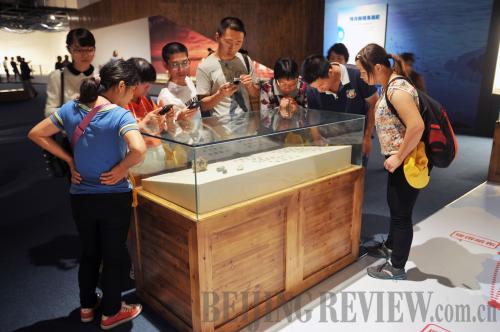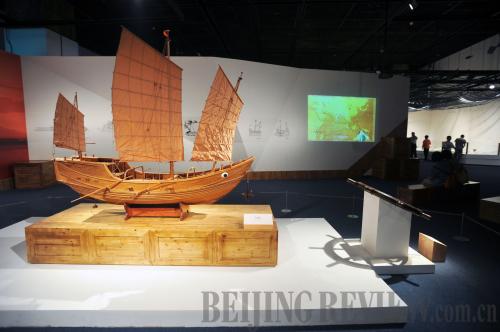|
 |
|
MONEY MATTERS: Visitors look at old coins salvaged from the sunken ship (WEI YAO) |
An exhibition showcasing the remains of an ancient sunken ship recently drew a flood of attention in Beijing upon its opening on August 22. The ancient ship named Huaguangjiao 1, enchanted the capital with its mysteries after laying untouched for almost 800 years underwater.
Huaguangjiao 1 was first discovered by a fisherman at the bottom of the South China Sea in 1996. It is also the first ancient ship found by the Xisha Islands in the South China Sea. As a merchant ship, it was found full of items for trade, including porcelain, bronze ware and stone implements. Huaguangjiao 1 was originally built in southeast China's Fujian Province during the Southern Song Dynasty (1127-1279). When it traveled by the Xisha Islands near Hainan Island, it hit the reef known as Huaguangjiao and sank, and this is where the ship got its name.
The ancient sunken ship has great archeological significance. It is a record of the history of ancient China's friendly exchanges with neighboring countries and it also exhibits China's world-leading navigation capabilities at the time, say experts.
 |
|
SUNKEN SHIP: A replica showcasing the ancient Huaguangjiao 1 at the Capital Museum in Beijing on September 12, 2013 (WEI YAO) |
Exhibition
"This exhibition is so great! It is so vivid and real. I feel like I am watching it set sail happily, sink regrettably and then finally get salvaged," said Wei Luxi, a 10-year-old primary school student who came to the exhibition with her parents.
Because the exhibition was open during the summer vacation, many parents took their children to go and see it, with the aim of giving their children a lesson in the history of navigation and to see ancient cultural relics.
The exhibit consists of five parts that work together to tell the ship's story, including how it would have looked originally when setting sail, how exactly the ship came to sink and the underwater archeological work undertaken in recovering the boat. In the exhibition hall, there are two specially designed sandpits. All cultural relics salvaged from the sunken ship were placed in the sandpits, to recreate the effect of looking at them on the sea bed where they were found.
The white sand was no ordinary sand either. Actual coral sand transported from Hainan Island, where the sunken ship was found, was used according to a museum attendant.
Out of all of the exhibits, which total more than 280, the precious antiques found inside the sunken ship were the main attraction. All of them are fine examples of artisan craft work of China at that time.
Underwater archeology
The salvaged wreck of Huaguangjiao 1 has a long story. First discovered by a Chinese fisherman in 1996, a preliminary salvaging was conducted two years later in 1998, and about 1,800 relics were brought out of the water from the wreck. However, the official underwater archeological work didn't start until 2007.
| 